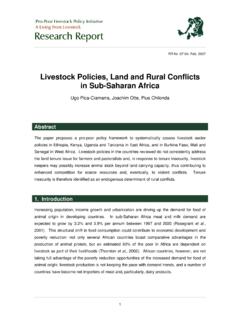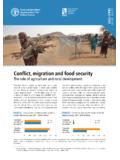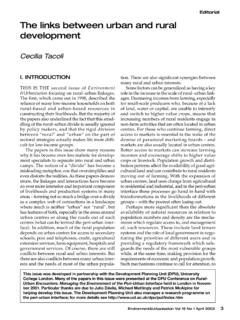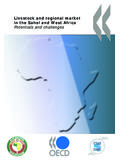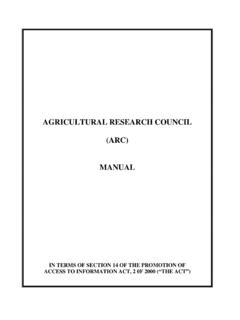Transcription of Performance Indicators for Sustainable Agriculture
1 Performance Indicators for Sustainable Agriculture (Discussion Note) October 1998 Julian Dumanski, Eugene Terry, Derek Byerlee, Christian Pieri Rural Development Sector The World Bank Washington, Disclaimer: The opinions presented in this paper are those of the authors, and do not represent any institutional positions or 1policies of the World Bank. Performance Indicators for Sustainable Agriculture (Discussion Note) Julian Dumanski, Eugene Terry, Derek Byerlee, Christian Pieri ABSTRACT Agriculture continues to make major and important contributions to global GNP, but society is beginning to demand that Agriculture becomes more than simply putting food on the table.
2 Sustainable Agriculture in the future will provide economic and social opportunities for the benefit of present and future generations, while maintaining and enhancing the quality of the environment and the natural resource base that supports production, and provides a basis for all terrestrial life on the planet. Agricultural systems in transition recognizes that farming systems are and always have been changing. In fact, it is this capacity to respond (rapidly) and to capture market, technology, environmental, and other opportunities, that will ensure Sustainable systems in the future.
3 Static agricultural systems are not Sustainable systems. Major factors that shape current agricultural change are shifts towards global markets, important advances in science and technology, and the emerging shift of emphasis from food security to reduction of rural poverty. The concept of sustainability as opportunity emphasizes that choices for future production systems are not compromised by decisions made today. This paper reviews biophysical and economic approaches to assessing Sustainable systems, and proposes a checklist, based on scientific principles and criteria, as a first step towards integrating these two approaches.
4 INTRODUCTION Agriculture that is truly Sustainable will not be business as usual. It will be a type of Agriculture that will provide environmental, economic and social opportunities for the benefit of present and future generations, while maintaining and enhancing the quality of the resources that support agricultural production. This will not be the Agriculture of to-day or of the recent past, with an emphasis on maximizing yields and economic returns, but rather one with the objectives of optimizing productivity and conserving the natural resource base.
5 The objective of optimization implies trade-offs in the production systems to ensure maintenance of environmental quality and global, environmental, and life support systems. Experience indicates that these tradeoffs will be defined and implemented voluntarily by farmers and other rural land users, or they will be implemented through policies and legislation. Society is beginning to demand that Agriculture become more than simply putting food on the table; it is beginning to demand that it also becomes the steward of rural landscapes.
6 The theme of the joint World Bank/Tri-Societies October 1998 workshop is Sustainability in Agricultural Systems in Transition . This theme is in recognition of the continued evolution of global Agriculture in response to the major factors which act to shape this evolution, namely, strategic shifts towards a global market place, important recent advances in science and technology, and the recent change in emphasis from food security to reduction of rural poverty. This also recognizes that Agriculture and the institutions and policies that support it have always been in a continual state of flux, although at different rates at different points in time.
7 Although some people view continual change with suspicion, it is indeed the capacity of agricultural systems to respond to change, the capacity to remain flexible, that will ensure Sustainable systems. Static agricultural systems, like the dinosaurs, are not Sustainable systems. For certain types of production systems, this transition will lead to a search for new opportunities to intensify production, increase productivity and exploit emerging commodity markets. In other cases, negative market forces 2and adverse natural conditions beyond the control of producers will lead to transition out of Agriculture and a search for off-farm employment.
8 This perpetual state of transition and evolution applies to all production systems from mono-culture production systems designed strictly to capture market opportunities to diversified systems employed by small-scale farmers to provide for household and market needs. For example, the largely mono-cropped wheat production systems in the northern Great Plains in North America are in transition due to a combination of bad weather, declining wheat prices, loss of soil quality, and a deadly fungus disease that has led to average losses in farm income of about $30,000 annually since 1994.
9 The diversified system practiced by farmers in the Cauca Valley of southwestern Colombia, based on coffee, plantains, common beans, fruits, and livestock, is also in transition. These farmers have recently adopted intensive production systems and management practices designed to control erosion on their steeply sloping land, including live barriers of sugarcane, various forage grasses, as well as the use of chicken manure as fertilizer, and the elimination of pesticides (Russell, 1998, personal communication).
10 Another example of production system in transition is in the Chipata District of Eastern Zambia where a group of largely women farmers have adopted a soil fertility improvement program on their maize farms by using local leguminous shrubs. Some of the immediate benefits include not only improvement of soil fertility and yields of hybrid maize of up to 4 tons/ha, but also extra fuel wood (Kwesiga, 1998, personal communication). Similarly, in transition is the system adopted by a large group of rice farmers in Indonesia who had experienced large crop losses, perhaps as much as a million tons annually, to the brown plant hopper.










